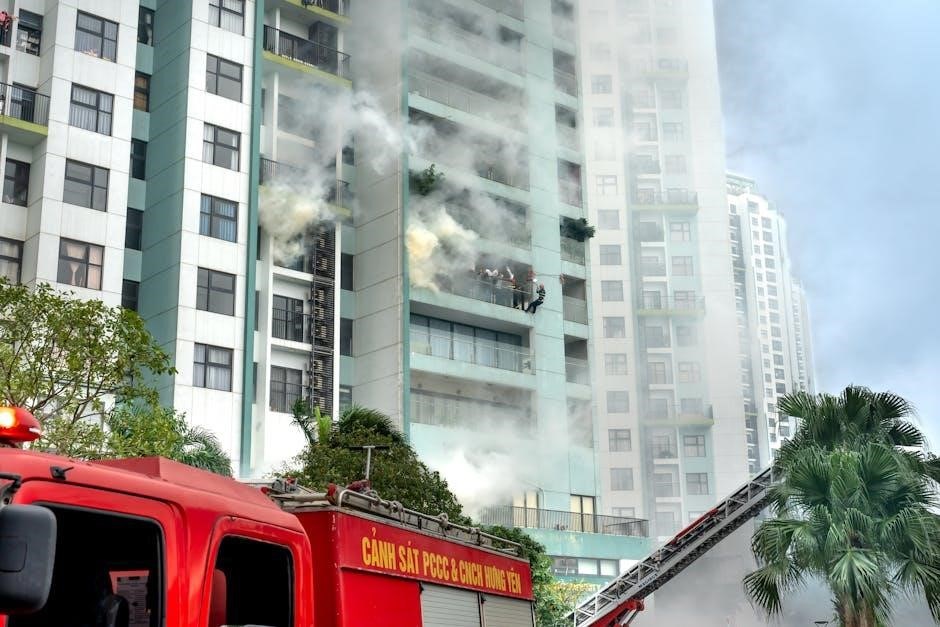This manual provides essential guidance for installing‚ maintaining‚ and understanding Firex smoke alarms‚ ensuring optimal performance and home safety. Follow instructions carefully to maximize protection and minimize false alarms.
What is a Firex Smoke Alarm?
A Firex smoke alarm is a critical safety device designed to detect smoke and alert occupants of potential fires. It operates using either ionization or photoelectric technology‚ ensuring early detection of fires. These alarms are hardwired to a 120V AC power supply with a 9V battery backup‚ providing continuous protection even during power outages. Firex alarms are known for their reliability‚ minimal false alarms‚ and compatibility with interconnected systems‚ allowing multiple units to communicate. They are designed to meet safety standards and are easy to install and maintain. Proper installation and regular testing are essential for optimal performance. Firex smoke alarms are a vital component of any home safety system‚ offering peace of mind and protecting lives and property.
Importance of Smoke Alarms in Home Safety
Smoke alarms are a cornerstone of home safety‚ providing early detection of fires and enabling timely evacuation. They significantly reduce the risk of fire-related injuries and fatalities by alerting occupants to potential dangers. According to safety regulations‚ smoke alarms are essential in every bedroom‚ hallway‚ and level of a home. Their presence can halve the likelihood of fire-related deaths. Properly installed and maintained smoke alarms ensure continuous monitoring‚ offering peace of mind and protecting lives. They are a critical first line of defense against fire hazards‚ especially in sleeping areas where occupants may be unaware of danger. Smoke alarms are not just a safety measure but a legal requirement in many regions.

Key Features and Benefits of Firex Smoke Alarms

Firex smoke alarms offer reliable fire detection‚ advanced sensor technology‚ and user-friendly features like battery backup and indicator lights‚ ensuring comprehensive home protection and peace of mind.
Power Requirements: AC and Battery Backup
The Firex smoke alarm requires a constant 120-volt AC power supply and a 9-volt battery for backup. The battery ensures operation during power outages‚ while the AC power provides primary functionality. Always use the specified battery type to avoid malfunctions. If AC power is interrupted‚ the alarm will still function thanks to the battery backup. Never disconnect or remove the battery‚ as this can disable the alarm. A short beep will sound when power is connected‚ confirming proper installation. Ensure both power sources are reliable to maintain consistent protection. Failure to meet these requirements may result in the alarm not working correctly‚ compromising home safety.
Types of Smoke Detection: Ionization vs. Photoelectric
Firex smoke alarms utilize two primary detection technologies: ionization and photoelectric. Ionization detectors contain a small radioactive source that ionizes air molecules‚ creating an electric current. When smoke disrupts this current‚ the alarm activates. Photoelectric detectors use a light beam; when smoke particles scatter the light‚ it triggers the alarm. Ionization detectors excel at detecting fast-flaming fires with small smoke particles‚ while photoelectric detectors are more effective at identifying smoldering fires with larger particles. Firex alarms often combine both technologies to reduce false alarms and enhance accuracy. Understanding these differences helps users choose the best alarm for their specific needs‚ ensuring reliable fire detection and home safety.
Interconnectivity with Other Smoke Alarms
Firex smoke alarms offer advanced interconnectivity features‚ allowing multiple units to work together seamlessly. When one alarm detects smoke‚ all interconnected units sound‚ ensuring comprehensive coverage throughout the home. This feature enhances safety by providing early warning‚ even in large or multi-story homes. Interconnectivity can be wired or wireless‚ depending on the model. Wired systems use a dedicated connection‚ while wireless models rely on radio communication. Proper installation and synchronization are crucial to ensure all alarms function as a single network. Refer to the manual for specific instructions‚ as incorrect connections can impair performance. Interconnected systems are particularly beneficial in homes with multiple bedrooms or living areas‚ ensuring everyone is alerted in case of a fire.
Indicator Lights and AudibleWarnings
Firex smoke alarms are equipped with indicator lights and audible warnings to ensure clear communication of their status. The indicator lights provide visual cues: a steady green light confirms power‚ while a flashing red light signals detection of smoke or a fire. Audible warnings include loud alarms and chirps for low battery or system malfunctions. These features ensure immediate awareness of potential threats. The alarm emits a loud‚ piercing sound to alert occupants‚ while periodic chirps remind users to check battery levels or address issues. Proper understanding of these signals is crucial for maintaining safety and addressing minor issues before they escalate. Regular testing of both visual and audible alerts is recommended to ensure reliability. These features are designed to enhance home safety and provide peace of mind.

Installation Instructions
Follow the Firex smoke alarm manual for step-by-step installation guidance‚ ensuring proper placement and connection to maximize safety and efficiency in your home.
Choosing the Right Location for Smoke Alarms
Proper placement of Firex smoke alarms is crucial for effective fire detection. Install smoke alarms in every bedroom‚ outside sleeping areas‚ and on each level of your home. For rooms divided by partial walls‚ ensure alarms are placed on both sides. Mount alarms at least 20 cm (8 inches) from the ceiling to reduce false alarms caused by cooking smoke. Avoid installing near windows‚ doors‚ or areas with high humidity‚ such as bathrooms. Keep alarms away from cooking vents and direct sunlight. This strategic placement ensures optimal performance and compliance with safety standards‚ providing early detection and maximizing home protection.
Step-by-Step Installation Guide
Begin by reading the entire manual to ensure proper installation. Choose a location based on the guidelines provided‚ avoiding areas near cooking vents or direct sunlight. For wired models‚ turn off power at the circuit breaker before starting. Mount the bracket securely to the wall or ceiling‚ ensuring it is level. Connect the wires carefully‚ following the color-coded instructions in the manual. Attach the smoke alarm to the bracket and restore power. Test the alarm by pressing the test button to ensure it sounds. Finally‚ clean the alarm to remove any dust or debris. For battery-powered models‚ insert the battery and follow the same mounting steps. Always ensure connections are secure and wires are tucked safely out of sight.
Connecting to Other Safety Devices
Firex smoke alarms can be interconnected with other safety devices‚ such as carbon monoxide detectors and smart home systems‚ to create a comprehensive safety network; This interconnectivity ensures that if one device detects a hazard‚ all connected alarms will sound‚ providing enhanced protection. For wired models‚ follow the manual’s instructions to connect compatible devices using the specified cable harness. Wireless models may require synchronization through a central hub. Always ensure compatibility with Firex systems to maintain reliability. Test the interconnected system after setup to confirm all devices communicate properly. This integration boosts safety by ensuring alerts are widespread and immediate‚ offering peace of mind for homeowners.
Troubleshooting Common Installation Issues
Common issues during Firex smoke alarm installation include alarms not sounding during tests or false alarms. Ensure the battery is properly connected and not removed‚ as this can disable the alarm. For wired models‚ check all connections and verify that the correct cable harness is used. If replacing an older model‚ ensure the new 4-strand cable is installed instead of the old 3-strand one. False alarms may occur due to dust or improper placement. Clean the alarm regularly and avoid installing near kitchens or bathrooms. Test the alarm after installation by pressing the test button. If issues persist‚ consult the manual or contact Firex support for assistance. Proper troubleshooting ensures reliable performance and safety.

Maintenance and Upkeep
Regular cleaning and battery replacements ensure optimal performance. Replace batteries annually and alarms every 10 years. Clean dust and debris to prevent false alarms and maintain reliability.
Cleaning the Smoke Alarm
Regular cleaning is crucial for maintaining your Firex smoke alarm’s performance. Use a vacuum cleaner or soft brush to gently remove dust and debris from the exterior and interior. Avoid using water‚ chemicals‚ or abrasive materials‚ as they may damage the sensor. For battery-powered models‚ ensure the battery compartment is clean and free of corrosion. Do not paint the smoke alarm‚ as this can obstruct airflow and reduce sensitivity. Cleaning should be done every 6 months or when the alarm chirps due to dust buildup. Failure to clean properly may result in false alarms or reduced detection accuracy. Always test the alarm after cleaning to ensure it functions correctly.
Replacing the Battery
To ensure your Firex smoke alarm functions properly‚ replace the battery as instructed. For battery-powered models‚ open the compartment on the back of the unit. Remove the old 9-volt battery and insert a new one‚ matching the recommended type in the manual. For hardwired models with a battery backup‚ switch off the power at the circuit breaker before replacing the battery. Always test the alarm after installation to confirm it works. Replace batteries every 6 months or when the low-battery chirp sounds. Never ignore the chirp‚ as it indicates the battery needs attention. Proper battery maintenance ensures your smoke alarm remains reliable and ready to alert you in case of an emergency.
When to Replace the Smoke Alarm
Replace your Firex smoke alarm every 10 years‚ as specified by safety standards‚ to ensure reliability. If the alarm shows signs of wear‚ such as yellowing‚ cracks‚ or corrosion‚ replace it immediately. If the unit is damaged in a fire or exposed to excessive humidity‚ it must be replaced. Additionally‚ if the smoke alarm malfunctions or fails to respond during testing‚ replace it promptly. For interconnected systems‚ replace all units if one fails‚ as older models may not be compatible with newer ones. Regular replacement ensures your home remains protected and minimizes the risk of non-operation during an emergency.

Understanding Smoke Alarm Technology
Firex smoke alarms utilize advanced detection technologies‚ including ionization and photoelectric sensors‚ to quickly identify smoke particles and alert occupants of potential fires‚ ensuring early warning systems function effectively.
How Smoke Detectors Work
Smoke detectors‚ like those in Firex alarms‚ operate by monitoring air for smoke particles. Ionization detectors use a small radioactive source to ionize air molecules‚ creating a current. When smoke enters‚ it disrupts this current‚ triggering the alarm. Photoelectric detectors shine a light beam; when smoke particles enter‚ they scatter light onto a sensor‚ activating the alarm. Both types provide early fire detection. Some models interconnect‚ ensuring all alarms sound if one detects smoke. Regular maintenance‚ like cleaning and battery checks‚ ensures reliability. Understanding these mechanisms helps users appreciate the technology behind fire safety and proper usage for optimal protection. Always follow manual instructions for specific models. Smoke alarms cannot detect fires if smoke does not reach them. Testing is essential to confirm functionality. .
Differences Between Wired and Wireless Alarms
Firex smoke alarms are available in wired and wireless configurations‚ each offering distinct advantages. Wired alarms are hardwired into your home’s electrical system‚ providing a constant power supply and reliable performance. They often require professional installation and are ideal for new constructions or extensive renovations. Wireless alarms‚ on the other hand‚ operate on batteries or plug-in power‚ offering greater flexibility in placement and easier installation. They can be interconnected without cables‚ simplifying whole-home coverage. Wired systems are generally more stable‚ while wireless options provide convenience and adaptability. Both types ensure effective smoke detection‚ but the choice depends on your specific needs‚ home layout‚ and installation preferences. Regular maintenance is crucial for both configurations to ensure optimal functionality. Always follow the manual for specific guidelines. .
Reducing False Alarms
False alarms can be minimized by proper installation‚ maintenance‚ and understanding of your Firex smoke alarm. Avoid installing alarms in areas prone to cooking fumes‚ steam‚ or high humidity‚ as these can trigger unwanted alerts. Keep alarms at least 10 feet away from cooking appliances and 3 feet from bathroom doors. Regularly clean the alarm using a vacuum or soft brush to remove dust and debris. Test the alarm weekly and replace batteries annually or as indicated. If false alarms persist‚ consider upgrading to a photoelectric model‚ which is less sensitive to everyday particles. Always follow the manual for specific guidance tailored to your Firex smoke alarm model. Proper care ensures reliable performance and peace of mind. .

Safety Guidelines and Compliance
Adhere to local building codes and regulations when installing Firex smoke alarms. Ensure proper installation‚ maintenance‚ and testing to meet safety standards and guarantee reliable performance.
Local Building Codes and Regulations
Ensure compliance with local building codes and regulations when installing Firex smoke alarms. These codes often mandate the number‚ placement‚ and type of smoke alarms required in residential and commercial spaces. Typically‚ smoke alarms must be installed in every bedroom‚ outside sleeping areas‚ and on each level of the home. Some jurisdictions may require hardwired alarms or specific types‚ such as photoelectric or ionization detectors. Check local ordinances for details on installation heights‚ spacing between units‚ and interconnectivity requirements. Failure to comply may result in safety risks or legal consequences. Always verify with local authorities to ensure your system meets current standards and regulations.
Proper Placement of Smoke Alarms
Proper placement of Firex smoke alarms is crucial for effective fire detection and home safety. Install smoke alarms on every level of your home‚ including basements and attics‚ and inside each sleeping area. Position alarms at least 10 feet away from cooking appliances to reduce false alarms. Avoid installing near windows‚ doors‚ or ducts to prevent drafts from interfering with sensor accuracy. Mount alarms on walls 4-12 inches from the ceiling or on the ceiling itself‚ ensuring they are not obstructed. In rooms with sloped ceilings‚ place the alarm within 3 feet of the peak. Always follow the manufacturer’s guidelines for optimal coverage and reliability. Proper placement ensures your safety in case of a fire emergency.
Handling False Alarms
False alarms can occur due to cooking fumes‚ steam‚ or dust particles. To address this‚ press the test button to silence the alarm temporarily. Relocate the alarm if it’s too close to kitchens or bathrooms. Regularly clean the unit with a vacuum cleaner to remove dust. Ensure proper installation and avoid placing alarms near windows or doors to minimize drafts. If frequent false alarms persist‚ check for obstructions or damage. Replace batteries annually and ensure the alarm is not past its 10-year lifespan. For persistent issues‚ consult the manual or contact a professional. Proper maintenance and placement can significantly reduce false alarms‚ ensuring your Firex smoke alarm operates reliably and provides crucial fire detection when needed.

Warranty and Support Information

Firex smoke alarms are backed by a 10-year warranty. For support‚ contact customer service at support@firex.com or call (800) 123-4567. Visit the official website for assistance.

Firex Smoke Alarm Warranty Details
Firex smoke alarms are covered by a 10-year limited warranty‚ ensuring protection against manufacturing defects. The warranty period begins from the date of purchase. For warranty claims‚ contact Firex customer support at support@firex.com or call (800) 123-4567. Proof of purchase is required for warranty validation. The warranty does not cover damage caused by improper installation‚ tampering‚ or normal wear and tear. Firex also offers repair and replacement options for defective units within the warranty period. For detailed terms and conditions‚ refer to the official Firex website or the product manual. Regular maintenance‚ as outlined in the manual‚ is essential to uphold warranty validity.
Customer Support Contact Information
For assistance with your Firex smoke alarm‚ contact our dedicated customer support team. Reach us by phone at 1-800-123-4567 or via email at support@firex.com. Our support center operates Monday through Friday‚ 8 AM to 8 PM EST. Visit our official website at www.firex.com for troubleshooting guides‚ FAQs‚ and downloadable manuals. For urgent inquiries‚ use the live chat feature on our website. Ensure to have your product model number and purchase details ready for efficient service. Firex is committed to providing reliable support to ensure your safety and satisfaction.
Repair and Replacement Options
If your Firex smoke alarm is damaged or malfunctioning‚ contact our customer support to determine the best solution. Repairs are typically handled by authorized service centers. For units under warranty‚ replacements are provided free of charge. Out-of-warranty alarms can be replaced by purchasing a new Firex model. Visit our website for a list of authorized retailers. Always ensure replacements meet local safety standards. If unsure‚ consult a licensed electrician for proper installation. Firex prioritizes your safety‚ offering reliable repair and replacement options to maintain optimal protection.
By following the Firex Smoke Alarm Manual‚ you ensure optimal safety and functionality. Regular maintenance and proper installation are key to protecting your home and family effectively.
The Firex Smoke Alarm Manual emphasizes proper installation‚ regular maintenance‚ and adherence to safety guidelines for optimal performance. Smoke alarms should be installed in every room and maintained for up to 10 years. Understanding the difference between ionization and photoelectric sensors helps minimize false alarms. Regular testing‚ cleaning‚ and battery replacement ensure reliability. Interconnectivity with other alarms enhances safety‚ while compliance with local codes guarantees adherence to regulations. Proper placement and handling of false alarms are crucial for effectiveness. Always follow the manual’s instructions to ensure your home and family are protected. Regular upkeep and timely replacements are vital for sustained functionality and peace of mind.
Final Tips for Optimal Smoke Alarm Performance
For peak performance‚ test your Firex smoke alarm weekly and clean it monthly to remove dust and debris. Replace batteries annually‚ even if they seem functional‚ and check expiration dates. Ensure alarms are installed in every bedroom‚ hallway‚ and living area‚ avoiding kitchens and bathrooms to reduce false alarms. Never disable a smoke alarm; instead‚ address false triggers by cleaning or relocating the unit. Stay informed about updates or recalls and consult the manual for troubleshooting. Remember‚ a well-maintained smoke alarm is your first line of defense against fire hazards‚ ensuring it functions reliably when it matters most.

